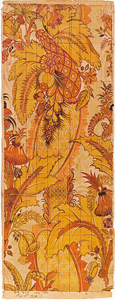
Dandridge
The first Dandridge recorded in Winslow is Geoffrey (d.1671), who married Alice Porter in 1643 and had 5 sons, at least 4 of whom died young. Thomas and Alice Dandridge bought a house in Shipton in 1652, and another messuage in 1662. Joseph Dandridge, who married Anne Eliot in 1664, was Thomas' son, and inherited some land from him in 1667. Joseph and Anne's son Joseph Dandridge was baptised on 2 March 1668 (another child with the same name was baptised in 1665 but presumably died young; however Joseph jr's date of birth is generally given as 1665). Their other surviving children were Francis, William, George, Anne (married Christopher Bigg) and Mary (married William Pursell of Thornborough in 1703), who all benefited under the will of their uncle William Elliott (d.1710). Two other children of Joseph Dandridge were buried at Winslow: Thomas in 1694 and Elizabeth in 1697 (daughter of Joseph and Ann). Joseph sr seems to have been an exciseman, as he was described in the Assize records for 1685, when he took the oath of allegiance, as "gawger" (=gauger, not gouger as suggested by Bristowe). When his son William became an apprentice blacksmith in London in 1687 he was described as "gentleman", and in 1693 he called himself "barber chirurgeon". He was constable for Winslow in 1696-7 and was buried on 16 Aug 1701. He is also found as the witness, and in some cases writer, of a number of Winslow wills in the late 1690s. "Frances wife of Joseph Dandridg", evidently his second wife, was buried on 11 Aug 1702.
 |
A silk pattern design by Joseph Dandridge, 1712, now in the Victoria & Albert Museum |
Joseph jr became a merchant taylor in 1686 (according to the admission of his son James to the freedom of the City of London in 1724), after serving an apprenticeship with John Cawne alias Corn(e) from 1679. He was a silk pattern designer and drawer in Moorfields, and eventually lived in Jewin Street. He cannot have been a Huguenot as is stated in some places. He described himself as freeman of the City of London and merchant taylor when he made his will in 1737. His claim to fame was as an entomologist; he is "the great forgotten figure of English entomology" according to one writer. He was a founder of the Society of Aurelians, who were butterfly collectors, and drew insects and collected drawings. A species of spider was named after him, Dandridgea dysderoides (although this was later regarded as misidentified). A writer quoted in the Gentleman's Magazine (June 1812) said: "I used to be frequently with him in the summer of 1740, and, though he was then upwards of 80, he was extremely affable and communicative. He told me many anecdotes of the old collectors, was very merry and chatty … He had a fine collection of natural history, as fossils, birds, shells, & c.; but his chief display was in insects, well kept and judiciously arranged, and shewed them with great pleasure, and with instruction". He died in London on 23 Dec 1747.
Joseph jr bought up land in Winslow and Shipton in 1692, and retained his connections with Winslow at least until the death of his uncle William Elliott in 1710, under whose will he inherited 40 acres of land. He sold all his property in Winslow to William Lowndes at a special manor court in August 1710.
Joseph jr mentions three children in his will: James, Elizabeth and Mary. He married Martha Lane at St James, Duke's Place, London, in 1686. Elizabeth, daughter of Joseph and Martha Dandridge, was baptised at All Hallows, London Wall in 1689. Martha must have died before Joseph made his will.
There are a number of other Dandridges whose relationship to each other is unclear:
- John Dandridge of Addington made his will in 1681
- John Dandridge of Winslow had a daughter Susan baptised in 1664.
- Widow Dandridge received distributions to the poor in 1687 and 1689. She may be the Ann Dandridge who was buried in 1691.
- George Dandridge (probably the son of Joseph sr) married Frances Stutsbury of Winslow at Granborough on 11 Nov 1698 and had several children baptised at Winslow from 1701.
- Another George Dandridge, barber, of Winslow, married Anne Waker of Winslow at Granborough on 26 Sep 1702.
- Another Joseph Dandridge, son of Francis, cordwainer (who was probably the son of Joseph sr), was bound apprentice to a London vintner, John Knapp jr, in 1706.
- Ann Dandridge married William Morris in 1729. She may be the same Ann Dandridge, widow, who was indicted at the Quarter Sessions in Jan 1724 for keeping a disorderly alehouse, and discharged.
The Dandridges disappear from Winslow records after this.
Joseph Dandridge has a Wikipedia entry, and there is a biographical article about him by W.S. Bristowe in Entomologist's Gazette 18 (1967), 73-89.
Back to Families / People
